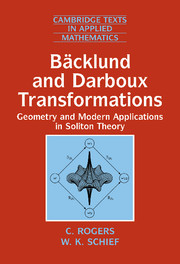Book contents
- Frontmatter
- Contents
- Preface
- Acknowledgements
- General Introduction and Outline
- 1 Pseudospherical Surfaces and the Classical Bäcklund Transformation. The Bianchi System
- 2 The Motion of Curves and Surfaces. Soliton Connections
- 3 Tzitzeica Surfaces. Conjugate Nets and the Toda Lattice Scheme
- 4 Hasimoto Surfaces and the Nonlinear Schrödinger Equation. Geometry and Associated Soliton Equations
- 5 Isothermic Surfaces. The Calapso and Zoomeron Equations
- 6 General Aspects of Soliton Surfaces. Role of Gauge and Reciprocal Transformations
- 7 Bäcklund Transformation and Darboux Matrix Connections
- 8 Bianchi and Ernst Systems. Bäcklund Transformations and Permutability Theorems
- 9 Projective-Minimal and Isothermal-Asymptotic Surfaces
- Appendix A The su(2)–so(3) Isomorphism
- Appendix B CC-Ideals
- Appendix C Biographies
- Bibliography and Author Index
- Subject Index
2 - The Motion of Curves and Surfaces. Soliton Connections
Published online by Cambridge University Press: 04 March 2010
- Frontmatter
- Contents
- Preface
- Acknowledgements
- General Introduction and Outline
- 1 Pseudospherical Surfaces and the Classical Bäcklund Transformation. The Bianchi System
- 2 The Motion of Curves and Surfaces. Soliton Connections
- 3 Tzitzeica Surfaces. Conjugate Nets and the Toda Lattice Scheme
- 4 Hasimoto Surfaces and the Nonlinear Schrödinger Equation. Geometry and Associated Soliton Equations
- 5 Isothermic Surfaces. The Calapso and Zoomeron Equations
- 6 General Aspects of Soliton Surfaces. Role of Gauge and Reciprocal Transformations
- 7 Bäcklund Transformation and Darboux Matrix Connections
- 8 Bianchi and Ernst Systems. Bäcklund Transformations and Permutability Theorems
- 9 Projective-Minimal and Isothermal-Asymptotic Surfaces
- Appendix A The su(2)–so(3) Isomorphism
- Appendix B CC-Ideals
- Appendix C Biographies
- Bibliography and Author Index
- Subject Index
Summary
The geometric link between soliton theory and the motion of inextensible curves may be said to have its origin in an analysis by Da Rios in 1906 on the spatial evolution of an isolated vortex filament in an unbounded, inviscid liquid. Therein, Da Rios, who studied under Levi-Civita at the University of Padua, invoked what is now known as the localized induction approximation to derive a pair of coupled nonlinear equations governing the time evolution of the curvature and torsion of the vortex filament. The importance of the Da Rios results were realised by Levi-Civita and they were subsequently collected and extended by him in a survey published in 1932. However, it was not until 1965 that the Da Rios equations were rediscovered by Betchov. In 1972, Hasimoto, motivated by the earlier geometric study of Betchov and preceded by experimental work on a distorted vortex ring by Kambe and Takao, showed that the Da Rios equations may be combined to produce the celebrated nonlinear Schrödinger equation of soliton theory.
Lamb, later in 1977, linked the spatial motion of certain curves with the sine-Gordon, modified Korteweg-de Vries and nonlinear Schrödinger equations. Lakshmanan et al. in turn, derived the Heisenberg spin chain equation via the spatial motion of a curve. In recent times, Doliwa and Santini established a connection between the motion of inextensible curves and solitonic systems via an embedding in a space of constant curvature.
Information
- Type
- Chapter
- Information
- Bäcklund and Darboux TransformationsGeometry and Modern Applications in Soliton Theory, pp. 60 - 87Publisher: Cambridge University PressPrint publication year: 2002
